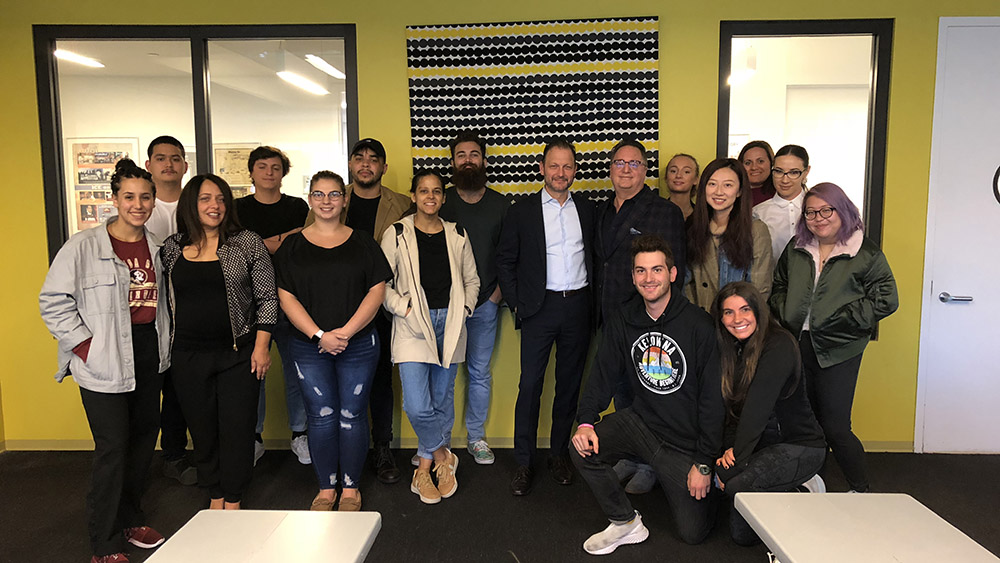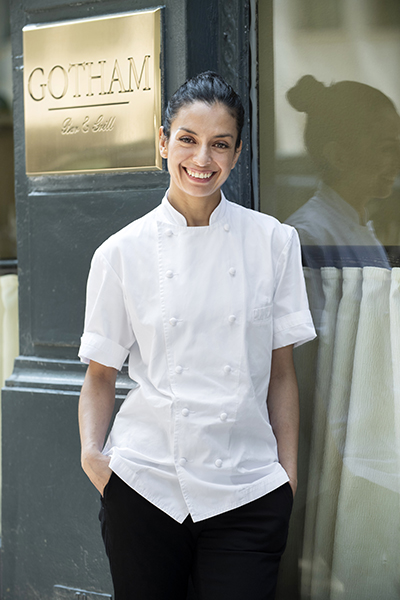Bret Csencsitz has more than 20 years of experience in the New York City restaurant industry. He launched his career under Daniel Boulud at Restaurant Daniel and Cafe Boulud, before joining Alfred Portale as the general manager at Gotham Bar and Grill, which became a downtown institution at a time when French restaurants in Midtown "reigned" as he put it.
Bret has balanced modernizing with extending a legacy during his 12-year tenure and shared insights on service, financials, ambiance and regulations with Restaurant & Culinary Management students last month. Here are eight highlights from his advice.
On how the industry has evolved over the last decade:
It’s much more regulated — more restrictions and legal obligations, mainly to do with tipping. It’s become a trickier business to manage with lots of rules and regulations. Minimum wage increases reduced profitability, which was already a difficult part of the business.
I see that consumer dining habits are changing: There are more options, there are more options at home, there are better delivery services. There are all these things competing now where restaurants used to reign. What you see is decreased traffic and less dining out.
The other thing that’s changed is that there are schools like ICE and people are taking this profession much more seriously, so the talent pool is increasing. That said, it’s one of the most difficult labor markets I’ve ever encountered. I spend two to three hours a day interviewing people and trying to schedule trails. I don’t have that much trouble finding managers. If you get a manager who has a lot of experience, they will often have ingrained habits or ways of doing things, and that can be problematic. Training young people or newer managers takes time and effort. Managing a restaurant is not rocket science but there’s a lot to do.

On the perks of management:
I find that people who lean towards front of house generally like social interaction. One of the greatest joys of the restaurant business is the fact that you get to talk to people all day long. A big part of managers' jobs is that interaction. Dealing with a customer who’s unhappy oftentimes creates an opportunity to gain a more loyal customer. Connection is what front of house people gravitate towards.
On his management style:
It’s changed over the years. I’m very transparent. I talk numbers and profit margins. My door is always open, I know every single employee’s name. I say hello to everybody when I walk in and I say goodnight when I can. This business is about the people who cook, the people who serve, and the people that we cook and serve it for. It’s your most important asset. My management style is open and honest. You have to show up. I also use humor.

On hiring a new chef after Alfred Portale moved on:
It’s one of the more difficult things I’ve done — a lot harder than I anticipated. Alfred Portale was there for 34 years and is very much associated with the restaurant ... We made a conscious decision to find an up-and-coming, new chef that’s going to help us usher in Gotham for a new generation with a new attitude and totally different approach.
We found Victoria Blamey who’s been around but hadn’t really hit her stride. She was born in Santiago, Chile, got into cooking in college, took some cooking classes there and went to a restaurant outside of London in Sussex. She learned there for two or three years, went to Australia and then came to Miami. In New York, she worked at Atera, Cortone and Upland. She opened as executive chef at Chumley’s, sort of a speakeasy concept. She was there for a year, did some media stuff and then we hired her. Her cooking is very different so all the people who’ve been coming for 25 years were stunned: Some people were thrilled, some were aghast.
On sustainability:
One of the things about Victoria is she’s deeply committed to sustainability. She has two fish on the menu right now: one is a Japanese sea bream, which is actually flown in from Japan. It’s called madai, which is interesting because nobody’s heard of madai so it’s a talking point. It’s a plus and minus: People are afraid of what they don’t know but from a service perspective, it gives us a chance to tell a story. The other one she has on there is a tilefish. It’s a great fish. It’s got a firm texture. It’s all up and down the Eastern Seaboard, largely focused in warmer waters off of Georgia and Florida. Completely sustainable, it’s on the green list. That’s an interesting component to what we’re doing, which I think attracts younger people because young people care a lot more about climate change and some of the issues that we’re facing with the environment.
I’m part of an organization called GrowNYC so I’ve been deeply committed to sustainable agriculture and local agriculture for the last 15 years. When I started, we introduced the beef program, became all no-antibiotics, no-hormones, largely grass-fed … In fine dining, you have lobster, high-end steak, luxury proteins, and now people are much more adventurous. You guys happened to grow up during an awesome time for American cooking and culinary. You started your eating life as an adult at a greater advantage.
On cost:
As general manager, your number one issue is controlling cost. It’s so easy to lose sight of it and control of it. It’s a constant battle to have perspective. Your number one cost in a restaurant — outside of real estate in New York City — is labor. You need people but you have to know what you’re spending on minimum wage and overtime.
On marketing:
I find marketing to be something everybody should be involved in. It forces you to define what you’re doing, why you’re doing it and what makes you different. If you’re not doing anything new, you have to face that question. Marketing is very useful for getting customers and internal understanding. We developed a concept called the Gotham Journal, which is what we call the internal newsletter/magazine. We did it first on paper. We would do two a year and follow a format. We would have a recipe and an interview with one of our purveyors. Then it turned electronic so now we have 40,000 people in our database who are very loyal. They read what we write. We have somebody on staff who helps us maintain it. It’s pretty powerful because we promote our partners. It helps us, it helps them. It creates great partnerships.
On ambiance:
We’ve changed the look of the interior minorly but in strategic ways. When I first got there, the color schemes were all over the place, and I created a monochrome look to modernize it. We lightened it up a little bit by changing some of the darker tones to lighter.
When it comes to things like music, I’m old-school. We have it in the bar area. In the dining room, I try to minimize. It’s about what happens at the table more than it is about what happens on the speakers. Oftentimes music is used as a way to disguise what’s really happening and it creates noise. We changed music in the sense that it was rock ‘n’ roll-heavy when I arrived, and I transitioned more to a classic jazz format.
Uniforms are tricky. There are legal requirements with uniforms in New York. It was khakis and a blue shirt when I got here and we went to black and white. We’ve eliminated vests, we have aprons. We have tried to speak to newer audiences and modernize.
Ambiance is always important. People will go and have lower-quality or less good food because they prefer to be in an atmosphere that allows them to entertain or be entertained.
Learn more about general management skills in Restaurant & Culinary Management.




